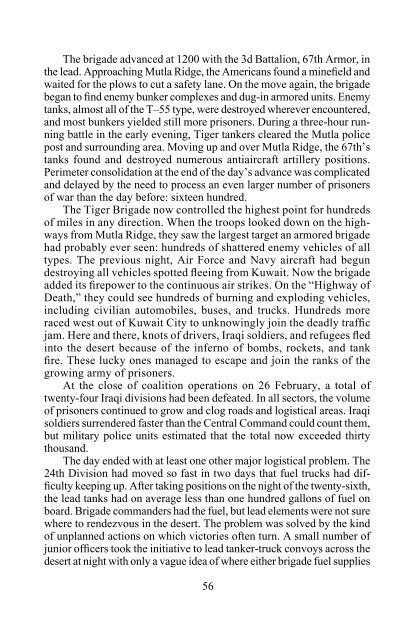You also want an ePaper? Increase the reach of your titles
YUMPU automatically turns print PDFs into web optimized ePapers that Google loves.
The brigade advanced at 1200 with the 3d Battalion, 67th Armor, inthe lead. Approaching Mutla Ridge, the Americans found a minefield andwaited for the plows to cut a safety lane. On the move again, the brigadebegan to find enemy bunker complexes and dug-in armored units. Enemytanks, almost all of the T–55 type, were destroyed wherever encountered,and most bunkers yielded still more prisoners. During a three-hour runningbattle in the early evening, Tiger tankers cleared the Mutla policepost and surrounding area. Moving up and over Mutla Ridge, the 67th’stanks found and destroyed numerous antiaircraft artillery positions.Perimeter consolidation at the end of the day’s advance was complicatedand delayed by the need to process an even larger number of prisonersof war than the day before: sixteen hundred.The Tiger Brigade now controlled the highest point for hundredsof miles in any direction. When the troops looked down on the highwaysfrom Mutla Ridge, they saw the largest target an armored brigadehad probably ever seen: hundreds of shattered enemy vehicles of alltypes. The previous night, Air Force and Navy aircraft had begundestroying all vehicles spotted fleeing from Kuwait. Now the brigadeadded its firepower to the continuous air strikes. On the “Highway ofDeath,” they could see hundreds of burning and exploding vehicles,including civilian automobiles, buses, and trucks. Hundreds moreraced west out of Kuwait City to unknowingly join the deadly trafficjam. Here and there, knots of drivers, Iraqi soldiers, and refugees fledinto the desert because of the inferno of bombs, rockets, and tankfire. These lucky ones managed to escape and join the ranks of thegrowing army of prisoners.At the close of coalition operations on 26 February, a total oftwenty-four Iraqi divisions had been defeated. In all sectors, the volumeof prisoners continued to grow and clog roads and logistical areas. Iraqisoldiers surrendered faster than the Central Command could count them,but military police units estimated that the total now exceeded thirtythousand.The day ended with at least one other major logistical problem. The24th Division had moved so fast in two days that fuel trucks had difficultykeeping up. After taking positions on the night of the twenty-sixth,the lead tanks had on average less than one hundred gallons of fuel onboard. Brigade commanders had the fuel, but lead elements were not surewhere to rendezvous in the desert. The problem was solved by the kindof unplanned actions on which victories often turn. A small number ofjunior officers took the initiative to lead tanker-truck convoys across thedesert at night with only a vague idea of where either brigade fuel supplies56












